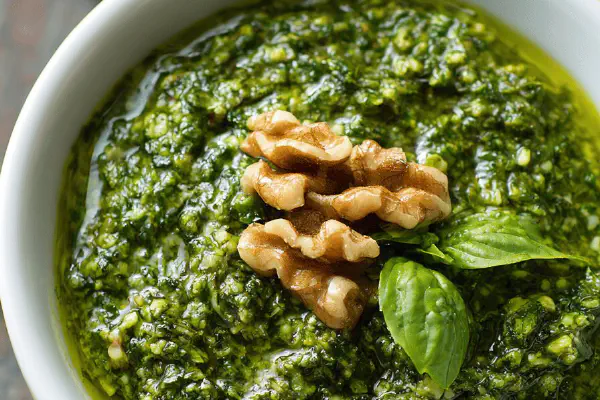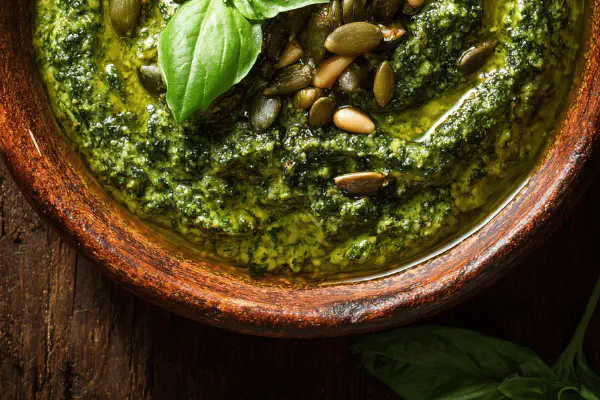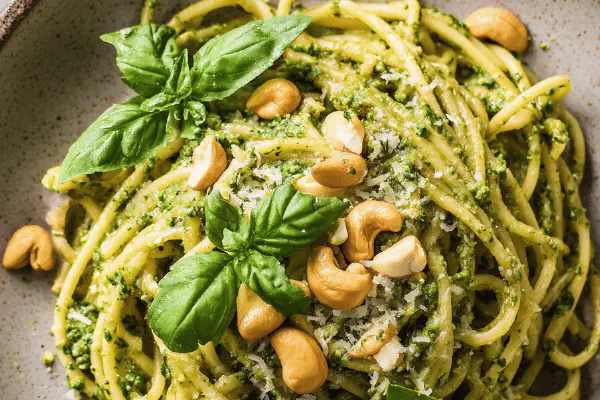Herb Citrus Pesto

By Emma
Certified Culinary Professional
Ingredients
- 85 g fresh basil leaves packed (about 3 cups)
- 40 g toasted walnuts (about 1/3 cup)
- 25 g Pecorino Romano finely grated (about 1/4 cup)
- 1 large clove garlic roughly chopped
- 15 ml fresh lemon juice (1 tablespoon)
- 15 ml fresh lime juice (1 tablespoon)
- 150 ml extra virgin olive oil, plus extra to adjust
- Salt to taste
About the ingredients
Method
- Toss basil, walnuts, Pecorino, and garlic into food processor bowl.
- Add lemon and lime juice before pulsing gently to combine. Stop before complete pureeing; want some rough texture.
- Turn machine on low; stream in olive oil slowly until mixture thickens but not too loose.
- Scrape down sides intermittently. Watch for rich green color and slight grainy texture.
- Taste. Salt gradually. Too sharp? Add more oil or a pinch sugar.
- Use immediately or refrigerate in airtight jar, covering surface with thin oil layer to prevent browning.
- Bring to room temp before using if chilled. Whisk gently to revive creaminess if oil separates.
- Great tossed in warm pasta still clinging to strands; classic garlic bread drizzle; or as dressing base.
Cooking tips
Chef's notes
- 💡 Pulser over blending fully keeps texture alive; chunkier bits give pesto character not just mush. Stop pulsing before pureed paste forms. Garlic chopped big provides punch but when overdone it turns pasty and dulls aroma. Watch basil leaves for freshness; slight bruising dulls green vibrance and flavor; no wilt or dark spots only.
- 💡 Olive oil stream matters—pouring too fast breaks emulsion, ends with oily separation or runny mix. Run machine on low speed slow steady drizzle until sauce thickens but still holds grit. Scrape bowl sides often, avoid stuck dry clumps; uneven mix ruins bite and color. Color is visual cue for emulsification progress; bright rich green means right balance.
- 💡 Swap ingredients based on allergies or pantry; toasted walnuts add crunch and earthiness but heavily toasted or burnt adds bitterness. Pepitas work but change texture, less richness. Pecorino Romano sharper than parmesan, salt levels vary, taste toward end. Citrus combo lemon plus lime brings cleaner bright acidity compared to lemon solo, balance oil and cheese.
- 💡 Salt last after tasting; cheese contains salt already so incremental addition avoids oversalting. Taste frequently between pulses; adjust garlic or oils as needed. If mixture gets too thick add splash more olive oil; too thin means nuts or cheese can be increased slowly. Texture and taste dependent on fresh ingredients so adjust by feel and smell rather than rigid measure.
- 💡 Store pesto in airtight jar; always cover surface with thin layer olive oil to prevent oxidation and browning. Refrigerate but bring to room temp before use; gentle whisk or stir to re-emulsify if oil separates, breaks but trust texture returns. Basil aroma and bright color fade once cold, warming revives subtle sensory cues.
Common questions
How do I avoid pesto getting bitter?
Toast nuts lightly only; watch smell and color closely. Burnt walnuts are bitter fast. Pulse garlic large chunks; overprocessing releases harsh notes. Citrus juice helps brightness but too much acid overwhelms. Balance is key.
Can I substitute the nuts or cheese?
Yes; pepitas swap nuts but less oily, texture changes. Parmesan softer, less sharp than Pecorino Romano; mix cheeses if needed. If dairy-free, omit cheeses, add nutritional yeast or salt more gradually.
Why is my pesto oily or too runny?
Olive oil stream too fast or too much at once breaks emulsion. Run machine low speed; drizzle slowly. Scrape frequently to reincorporate. If runny add more nuts or cheese to thicken; chill helps firm up as well.
How long can I keep pesto in the fridge?
Few days to a week max if oil surface sealed tight. Use airtight container always. Top with thin oil layer to prevent browning. Can freeze but texture changes. Always warm and stir before serving.



